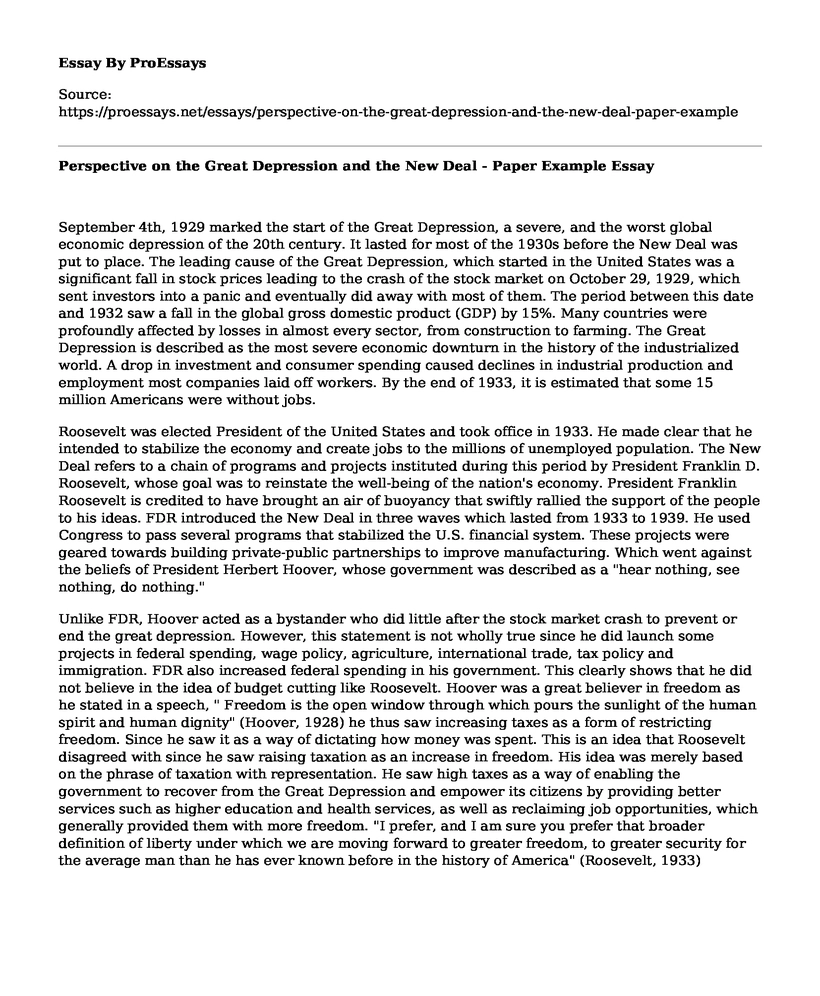September 4th, 1929 marked the start of the Great Depression, a severe, and the worst global economic depression of the 20th century. It lasted for most of the 1930s before the New Deal was put to place. The leading cause of the Great Depression, which started in the United States was a significant fall in stock prices leading to the crash of the stock market on October 29, 1929, which sent investors into a panic and eventually did away with most of them. The period between this date and 1932 saw a fall in the global gross domestic product (GDP) by 15%. Many countries were profoundly affected by losses in almost every sector, from construction to farming. The Great Depression is described as the most severe economic downturn in the history of the industrialized world. A drop in investment and consumer spending caused declines in industrial production and employment most companies laid off workers. By the end of 1933, it is estimated that some 15 million Americans were without jobs.
Roosevelt was elected President of the United States and took office in 1933. He made clear that he intended to stabilize the economy and create jobs to the millions of unemployed population. The New Deal refers to a chain of programs and projects instituted during this period by President Franklin D. Roosevelt, whose goal was to reinstate the well-being of the nation's economy. President Franklin Roosevelt is credited to have brought an air of buoyancy that swiftly rallied the support of the people to his ideas. FDR introduced the New Deal in three waves which lasted from 1933 to 1939. He used Congress to pass several programs that stabilized the U.S. financial system. These projects were geared towards building private-public partnerships to improve manufacturing. Which went against the beliefs of President Herbert Hoover, whose government was described as a "hear nothing, see nothing, do nothing."
Unlike FDR, Hoover acted as a bystander who did little after the stock market crash to prevent or end the great depression. However, this statement is not wholly true since he did launch some projects in federal spending, wage policy, agriculture, international trade, tax policy and immigration. FDR also increased federal spending in his government. This clearly shows that he did not believe in the idea of budget cutting like Roosevelt. Hoover was a great believer in freedom as he stated in a speech, " Freedom is the open window through which pours the sunlight of the human spirit and human dignity" (Hoover, 1928) he thus saw increasing taxes as a form of restricting freedom. Since he saw it as a way of dictating how money was spent. This is an idea that Roosevelt disagreed with since he saw raising taxation as an increase in freedom. His idea was merely based on the phrase of taxation with representation. He saw high taxes as a way of enabling the government to recover from the Great Depression and empower its citizens by providing better services such as higher education and health services, as well as reclaiming job opportunities, which generally provided them with more freedom. "I prefer, and I am sure you prefer that broader definition of liberty under which we are moving forward to greater freedom, to greater security for the average man than he has ever known before in the history of America" (Roosevelt, 1933)
Conclusion
In the case of results, it is clear that FDR's New Deal methods worked better to suppress the Great depression, unlike Hoover's who many saw as a spectator president. It is therefore appraisable what the New Deal did to restore the economy that had been significantly affected by the depression. His policies which included raising taxes for products such as liquor, then came more taxes on corporate dividends, hence reducing deductions for capital and business losses. The New Deal also saw an additional charge on food processors and other individual taxes on farmers who produced more than the government permitted. Finally, there came a 5 percent tax on corporate net income exceeding 12 percent of a corporation's capital stock. More charges came to follow, but thanks to them, Roosevelt's term saw a considerable recovery of the United States' economy, leading to the end of the Great Depression.
References
Roosevelt, F. D. Fireside Chat, September 30, 1934. Online by Gerhard Peters and John T. Woolley, The American Presidency Project. https://www.presidency.ucsb.edu/node/208160
Short, B. (1991). The Rhetoric of the Post-Presidency: Herbert Hoover's Campaign against the New Deal, 1934-1936. Presidential Studies Quarterly, 21(2), 333-350.
Cite this page
Perspective on the Great Depression and the New Deal - Paper Example. (2022, Dec 05). Retrieved from https://proessays.net/essays/perspective-on-the-great-depression-and-the-new-deal-paper-example
If you are the original author of this essay and no longer wish to have it published on the ProEssays website, please click below to request its removal:
- Key Turning Points of United States Civil War
- The Deer Hunter Movie Essay
- Religion, Morals, and Slavery Essay
- Article Analysis Essay on 'King Philip's Herds: Indians, Colonists, and the Problem of Livestock in Early New England'
- French Revolution: People's Dissatisfaction With Leadership - Essay Sample
- Paper Sample on Racism in US: A Legacy of Colonialism & Inequality
- Essay Sample on Roaring '20s: A Decade of Growth & Change in America & Beyond







